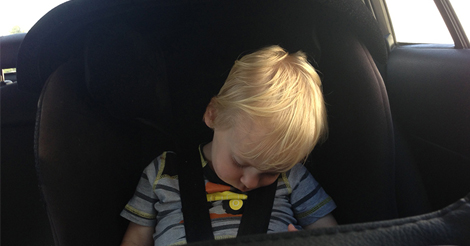
Thanks to Infa-Secure for this terrific post on head flop.
We get a lot of questions about children falling asleep in their child restraints, and how to stop or minimise their heads falling forward when they do. ‘Head flop’ is a complicated issue, and there isn’t a simple single answer.
Slump
A child’s head falling forward or to the side when they fall asleep in their child restraint is something that can happen in any forward facing child restraint. There are a number of issues that can contribute to this – the angle of recline of the vehicle seat back or seat base, the recline adjustment of the child restraint, the position of the child in the restraint, padding, pillows and headrest positions and the way in which the restraint has been installed. Many parents find that the same child in the same child restraint falls forward in one car but not another, or that one child will fall forward, but another in the same car and same restraint won’t.
When we design a child restraint, we must comply with the Australian Standard AS/NZS 1754. This is a mandatory standard, and it has some of the most stringent requirements in the world. This standard restricts the level of recline of a child restraint to be less than 45 degrees from the vertical, which is measured whilst sitting on a vehicle test seat base.
The Australian Standard committee CS085 decided to limit the amount of recline allowed to 45 degrees, as there was a concern that by increasing the recline angle, the child is then laying back. For forward facing restraints, instead of distributing the impact forces over the area of contact between the child’s body and the webbing of the inbuilt harness (in a forward facing carseat) or seat belt (in a booster seat) during a frontal crash, the child could have a propensity to slide down into the seat base, and cause a dynamic compressive load of the child’s spine. Basically, their neck and spine could take the increasing loads during the impact force, rather than having it spread evenly over their chest and torso.
Is slumping dangerous?
We feel that the potential for injury is dependent on the arc traced by the head during a side impact crash, and whether the child’s head would come back within the side wings or not before contacting anything. It’s not actually testable with the current generation of crash test dummies, which cannot be positioned with their heads slumped forward to simulate sleeping. We approached Neuroscience Research Australia regarding this, and they commented that in reality there is very little real world data to answer this question, as we almost never know what position a child’s head was in at the time of a crash.
When child restraints are tested to the Australian Standard for compliance (and also for CREP) all testing is conducted with an average sized child for the age range of the child seat, with the child seat in both the most upright and most reclined positions (as permitted by the Standard). No testing is conducted to determine the child restraints ability to offer protection to the child whilst they are either asleep or sitting out of position (as mentioned above, this is currently un-testable).
An interesting parallel to this can be seen in the greater motor vehicle industry. Every motor vehicle manufactured and sold in Australia must meet the Australian Design Rules, and when testing the car’s airbags and seat belts, the testing is done with an average sized adult sitting the front seats with the recline angle set as per the manufacturers specifications (nominally 20 degrees) and the seat positioned in the central track. No testing is conducted of the vehicle with the adult asleep or sitting out of position.
What can we do?
So while we can’t control every aspect of every specific child / restraint / vehicle combination, we can take preventative steps to minimise the chance of our children’s heads falling forward.
We recommend that parents check that a restraint is suitable for both their child and their vehicle. Most baby stores will allow you to try a seat in your vehicle prior to purchase. Be sure to try the recline settings, and if your child is old enough, ask them to pretend to sleep, or go as floppy as they can – make a game out of it!
Plan for longer trips ahead of time by adjusting your vehicle’s back seat recline (if possible) or installing the restraint in its most reclined configuration.
Ensuring the child is fitted in the restraint correctly can help minimise the amount a child falls forward. The key here is a correctly fitted harness – it should be snug, and you should only be able to get a single finger under it.
Using a folded cloth nappy or towel under rearward facing child restraints to assist with giving it adequate recline, keeping in mind not to recline the child seat more than 45 degrees from the vertical.
IMPORTANT!
We do not recommend third party or after-market pillows, supports or accessories to ‘prop’ the child’s head up, as these may alter the performance of the restraint in an accident and could pose a safety risk to the child and / or other passengers in the vehicle. Products which specifically restrain the child’s head within the seat are excluded from the Australian Carseat Accessory Standard AS/NZS 8005:2013 under clause 3.2, as they are viewed to have serious potential for injury to the child in the event of an accident. We strongly recommend against the use of these kinds of products. In addition to being potentially dangerous, they are a band-aid fix for a larger problem, and we feel they promote a lax attitude toward making sure a child is fitted correctly in the correct kind of child restraint.
Visit Infa-Secure here by clicking this link.
